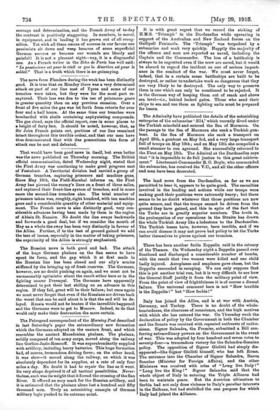The Petrograd correspondent of the Morning Pod described in last
Saturday's paper the extraordinary new formation which the Germans adopted on the eastern front, and which resembles the ancient Macedonian phalanx. The phalanx, solidly composed of ten army corps, moved along the railway line Gorlice.Jaslo-Rzeszoff. It was superabundantly supplied with artillery, including heavy batteries. This huge formation had, of course, tremendous driving force; on the other hand, it was slow—it moved along the railway, on which it was absolutely dependent for its supplies, at a rate of only four miles a day. No doubt it had to repair the line as it went. Its very shape deprived it of all tactical possibilities. Never. theless, such was its weight that it forced the crossing of the San River. It offered an easy mark for the Russian artillery, and it is estimated that the phalanx alone lost a hundred and fifty thousand men. Truly an astonishing example of German military logic pushed to its extreme -point.
It is with great regret that we record the sinking of H.M.S. ' Triumph' in the Dardanelles while operating in support of the Australian and New Zealand forces on the Gallipoli Peninsula. The 'Triumph' was torpedoed by a submarine and sank very quickly. Happily the majority of the officers and men are reported as saved, including the Captain and the Commander. The loss of a battleship is always to be regretted even if the crew are saved, but it would be absurd to regard the incident as one of serious import- ance in the conduct of the war. We must never forget, indeed, that in a certain sense battleships are built to be destroyed, or rather to undertake work so dangerous that they are very likely to be destroyed. The only way to preserve them is one which can only be mentioned to be rejected. It is the German way of keeping them out of reach and above sea level—i.e., behind locked gates. Those who send their ships to sea and use them as fighting units must be prepared for losses.


































 Previous page
Previous page